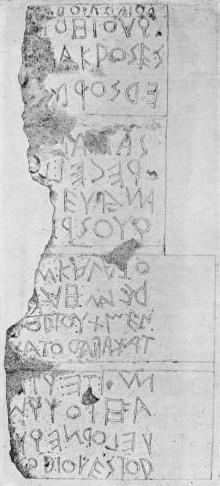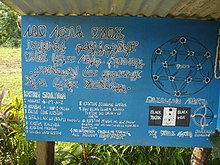Материал из Википедии — свободной энциклопедии
Сюда перенаправляется запрос «Двунаправленное письмо». На эту тему нужна отдельная статья.
Гортинские законы — пример текста, записанного бустрофедоном на дорийском диалекте древнегреческого языка.
Бустрофедон встречается в памятниках лувийского, южноаравийского, этрусского, греческого, малоазийских и других видов письма.
См. также
Литература
- Бустрофедон // Энциклопедический словарь Брокгауза и Ефрона : в 86 т. (82 т. и 4 доп.). — СПб., 1890—1907.
Boustrophedon
From Wikipedia, the free encyclopediaAncient Greek boustrophedon inscription, Gortyn code, Crete, 5th century BCBoustrophedon /ˌbuːstrəˈfiːdən/ (Ancient Greek: βουστροφηδόν, boustrophēdón “ox-turning” from βοῦς, bous, “ox”, στροφή, strophē, “turn” and the adverbial suffix -δόν, "like, in the manner of"; that is, turning like oxen in ploughing)[1][2] is a kind of bi-directional text, mostly seen in ancient manuscripts and other inscriptions.[3] Every other line of writing is flipped or reversed, with reversed letters. Rather than going left-to-right as in modern European languages, or right-to-left as in Arabic and Hebrew, alternate lines in boustrophedon must be read in opposite directions. Also, the individual characters are reversed, or mirrored. It was a common way of writing in stone in Ancient Greece.[4] The Forum inscription (one of the oldest known Latin inscriptions) is written boustrophedon, albeit irregularly: reading from top to bottom, lines 1, 3, 5, 7, 9, 11, 12, 14, 16 run from right to left; lines 2, 4, 6, 8, 10, 13, and 15, from left to right; 8, 9, and 16 are upside down. (From a rubbing by Domenico Comparetti.)
The Forum inscription (one of the oldest known Latin inscriptions) is written boustrophedon, albeit irregularly: reading from top to bottom, lines 1, 3, 5, 7, 9, 11, 12, 14, 16 run from right to left; lines 2, 4, 6, 8, 10, 13, and 15, from left to right; 8, 9, and 16 are upside down. (From a rubbing by Domenico Comparetti.)
Contents
Explanation
Many ancient scripts, such as Safaitic and Sabaean, were frequently or typically written boustrophedonically, but in Greek it is found most commonly in archaic inscriptions, becoming less and less popular throughout the Hellenistic period.An example, in English, of the style of Boustrophedon as written in ancient manuscripts in Greece (lines 2 and 4 read right–to–left)
By analogy, the term may be used in other areas to describe this kind of alternation of motion or writing. For example, it is occasionally used to describe the print head motion of certain dot matrix printers. In that case, while the print head moves in opposite directions on alternate lines, the printed text is usually not in boustrophedon format.[5]
The Hungarian folklorist Gyula Sebestyén (1864-1946) writes that ancient boustrophedon writing resembles how the Hungarian rovás-sticks of old Hungarian writing were made by shepherds. The notcher holds the wooden stick in his left hand, cutting the letters with his right hand from right to left. When the first side is complete, he flips the stick over vertically and starts to notch the opposite side in the same manner. When unfolded horizontally (as in the case of the stone-cut boustrophedon inscriptions), the final result is writing which starts from right to left, and continues from left to right in the next row, with letters turned upside down. Sebestyén states that the ancient boustrophedon writings were copied from such wooden sticks with cut letters, applied for epigraphic inscriptions (not recognizing the real meaning of the original wooden type).[6]
Reverse boustrophedon
The wooden boards and other incised artifacts of Rapa Nui also bear a boustrophedonic script called Rongorongo, which remains undeciphered. In Rongorongo the text in alternate lines was rotated 180 degrees rather than mirrored; this is termed reverse boustrophedon.Schematic of reverse boustrophedon text, in the fashion of rongorongo, but using the Latin alphabet
Example of Hieroglyphic Luwian
The Luwian language had a hieroglyph version, hieroglyphic Luwian, that read boustrophedon[7] (most of the language was written down in cuneiform).
The Hieroglyphic Luwian is read boustrophedon, with the direction of any individual line pointing into the front[meaning ambiguous: obverse to the front or pointing the same way as it?] of the animals or body parts constituting certain hieroglyphs. However, unlike Egyptian hieroglyphs with their numerous ideograms and logograms which show an easy directionality, the lineal direction of the text in hieroglyphic Luwian is harder to see.
Other examples
A modern example of boustrophedonics is the numbering scheme of sections within survey townships in the United States and Canada. In both countries, survey townships are divided into a 6-by-6 grid of 36 sections. In the U.S. Public Land Survey System, Section 1 of a township is in the northeast corner, and the numbering proceeds boustrophedonically until Section 36 is reached in the southeast corner.[8] Canada's Dominion Land Survey also uses boustrophedonic numbering, but starts at the southeast corner.[citation needed]
Rongorongo is the current theory of the first written language on Easter Island. It is believed to be written in boustrophedonics, yet no accurate translation has been deciphered. Rongorongo shares many characterestics with other Polynesian languages groups.
The term is used by postmen in the United Kingdom to describe street numbering which proceeds serially in one direction then turns back in the other.[citation needed] (The same numbering method is used in some European cities.) This is in contrast to the more common method of odd and even numbers on opposite sides of the street.
In art history, it additionally means that you read from bottom left in a series of pictures; as in the stained glass windows at Sainte-Chapelle in Paris.[citation needed]
Another example is the boustrophedon transform, known in mathematics.[9]
Sometimes computer printers with a typewriter-like moving type head print boustrophedon text if set up incorrectly.[citation needed]
The IBM 1360 Photo-Digital Storage System records its data boustrophedonically.[citation needed]
Additionally, the Indus script, although still undeciphered, can be written boustrophedonically.[10]
The Avoiuli script used on Pentecost Island in Vanuatu can be written boustrophedonically.[citation needed]Notice in Avoiuli script written using boustrophedon
In constructed languages
The constructed language Ithkuil uses a boustrophedon script.
The Atlantean language created by Marc Okrand for Disney’s 2001 film Atlantis: The Lost Empire is written in boustrophedon to recreate the feeling of flowing water.
The code language used in The Montmaray Journals, Kernetin, is written boustrophedonically. It is a combination of Cornish and Latin and is used for secret communication.[11]
The written language of the Minbari in the television series Babylon 5 is written in boustrophedon. This is evidenced by the episode in which Ambassador Delenn is dictating a formal letter, and the computer dictation writes the alien script starting top-to-bottom and changing from right-to-left or left-to-right for each new line.
See also
- Mirror writing
- Sator square is read boustrophedon in one interpretation
- Stoichedon
References
- Cooper, Michelle (2008). A Brief History of Montmaray. Australia: Random House Australia. ISBN 9780375858642.
External links
| Look up Boustrophedon in Wiktionary, the free dictionary. |
| Wikimedia Commons has media related to Boustrophedon. |




